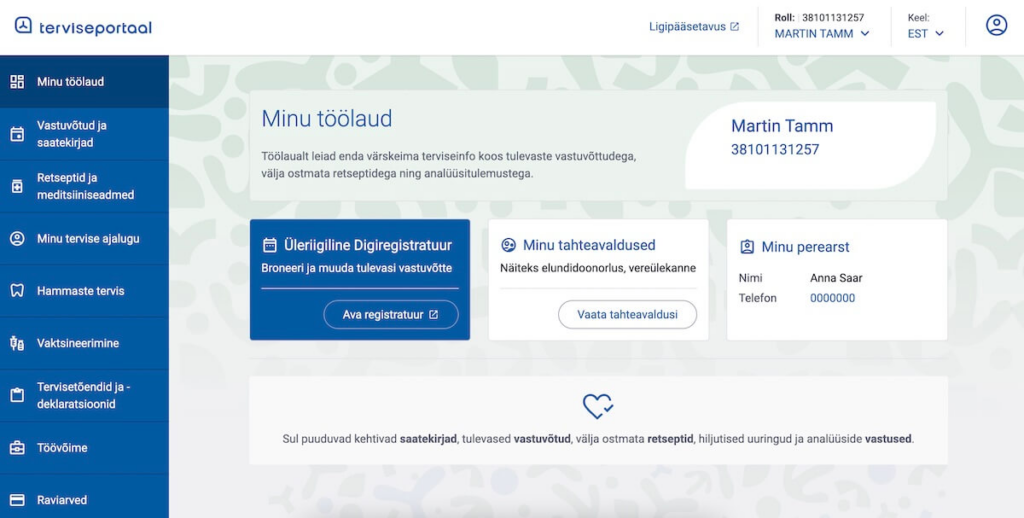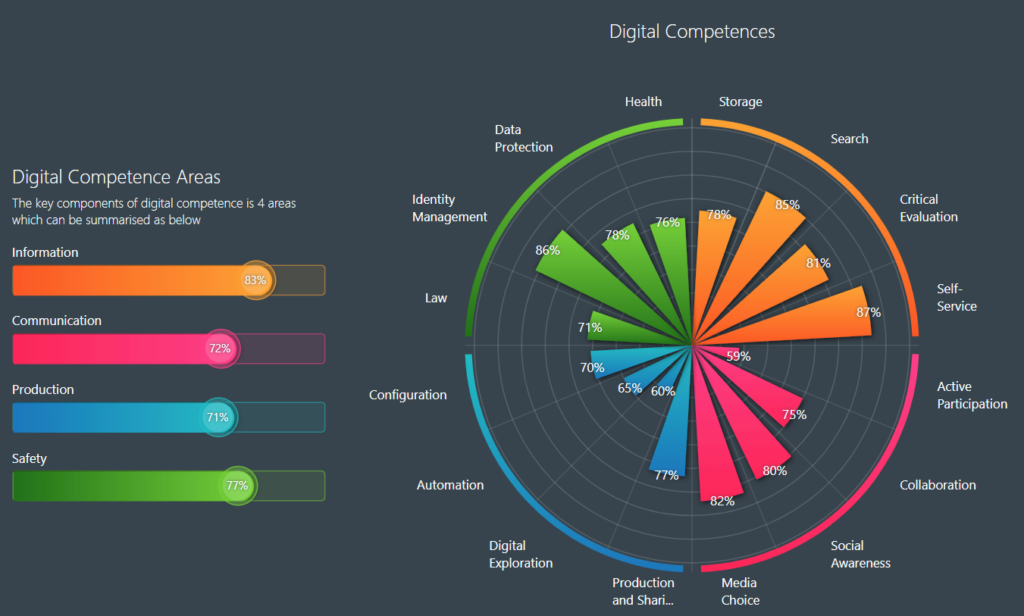Digital social services applications in Estonia
Estonia has digital self-service systems for all government-provided services as well as eesti.ee which acts as an official portal compiling all e-services available for citizens while providing information on several important topics related to those services (Eesti Riigiportaal, 2024). So if you do not know where to declare your taxes, see your medical prescriptions, or change your driver’s license, the landportal eesti.ee will have the information and guide you to the correct ministry’s self-service site if you need more specific information.

You can access digital national services using either Mobile-ID, Smart-ID, ID card or any other EU-wide eID. Logging into services using bank details is not possible (you log into your bank account using the same methods as for government services).
Social services are accessible from Sotsiaalkindlustusameti iseteenindus (SKAIS) or eesti.ee portal (Sotsiaalkindlustusamet, 2024). Estonia has been redesigning their national websites in recent years and that is also visible when you visit SKAIS. The homepage shows, for example, whether you have any new messages or notifications and if you can apply for any assistive measures. From the menu, you can see any benefits or support you might qualify for, information on any topic (pensions, child support, disability), view your documents, your contact information, different calculators, social service consultation bookings, or money transfers related to social services. The entire website is created with accessibility in mind, it is Web Content Accessibility Guidelines (WCAG 2.0 AA) compliant.

My experience with the social service site is limited to only applying for assistive tools as study support is tightly regulated and often people do not qualify for it. And my fat cat does not constitute a child so no child support.
Digital healthcare services in Estonia
The national e-service for healthcare is Terviseportaal, previously known as Digilugu (Tervise ja Heaolu Infosüsteemide Keskus, 2024). It has gone through a glow-up in the past two years and gained a much sleeker visual design although with it they have forgone some previously implemented accessibility features like choosing text size and contrast on the webpage itself. They explain how it is easy to do those actions on all modern browsers so a separate function for it is necessary. The site is still WCAG 2.1 compliant.
Without logging in you can access general healthcare-related information and find contact information for different institutions like the Poison Information Center. When you log in, you can view a lot of information such as:
- Medical history including laboratory tests, radiographic analyses, medical cases, hospital stays, ER visits, etc
- Dental information such as the state of your teeth or unused dental healthcare support
- Drug or medical device prescriptions, both current and past
- Health certificates for different purposes such as for a driver’s license
- Vaccination information such as your history or recommendations
- Doctor’s visit appointments and referrals, it can direct you to Digiregistratuur (healthcare appointment registry) for time booking
- Sick leave or parental leave information
You can also see your documents, access logs to see who has viewed your information, assign crisis contacts, decide on organ donation, and much more interesting. I recommend the site a lot. I use Terviseportaal a lot in my everyday life for things such as viewing my prescriptions, referrals, or lab test results. So far digital healthcare services have been getting better and better although sometimes it seems that the sheer amount of them might be overwhelming to some people.

Online shopping and services
I have mostly preferred visiting physical stores to online shopping although there are certain exceptions such as bookstores where I can order books not physically available in my usual store and retrieve them from there. With physical things, I tend to use online stores when it is not possible to buy something in person such as a custom-made belt from a local craftsman as a gift for my dad. I have used online grocery stores when I’ve been infected with the coronavirus as it is immoral to go sneezing between the store aisles.
I have used Amazon once or twice as a teenager when co-ordering with someone else but otherwise, I avoid it. While it has a wide selection of items on offer with some good deals, the information provided is not sufficient for me to feel comfortable enough to order something. It is difficult to discern the reliability of the seller (or even who the seller is in some cases) or product or delivery options, so I much prefer to get things straight from the supplier’s own site if I do need to order online.
Online services, on the other hand, are something I like. Whether it is buying ship tickets online or on an app, booking hostels, finding dentist appointments, or getting seats for a movie session, online services are much more comfortable to use. It is much easier to find all the information I need for services through the Internet and I don’t have to do it somewhere loud and busy such as a shopping center.
All in all, I think the reliability of online commercial services varies a lot. For that reason, it is important to do some background research before committing to a new and unknown site. You can ask for opinions and experiences in your social circle, read online reviews (critically because online reviews can also be faked or bought), and think through whether the deal is too good to be real.
Perearst24, a web application to access your GP’s office
As my chosen healthcare-related application I have Perearst24, a portal that will allow you to send information towards your GP’s office or clinic even during off-work hours (Certific, 2024). You can access the services through the same identification processes as most national services. When logged in, you can choose whether you want to share information about yourself or any minors you are responsible for, the clinic, and the general practitioner you are under. After that you get a wide selection of different topics you can make an e-contact about such as starting or ending sick leave, canceling a visit, reporting an acute infection (colds, digestive infections, rashes, etc), refilling prescriptions, asking for referrals for doctors or laboratory tests, vaccinations, or apply for a health certificate. It also has a section to report any skin problems, back pain, ligament- and muscle-related ailments, mental health problems, toddler health checkups, headaches, and much more. If you can’t find a suitable option, you can send your message as “other health problem”. All these options are illustrated with minimalistic icons. In general, the site is very clutter-free and available in Estonian, Russian, and English. In the menu option, you can see any e-contacts you have started with your GP’s office or reply to any ongoing ones.
Each e-contact or case will include all relevant information the nurse might ask from you. For example, if you are reporting an acute respiratory infection, it guides you through the entire process: different symptoms you might have, your body temperature, when symptoms started to show, if you want to open sick leave, whether you prefer a physical or phone consultation, and you can even add files if needed.
The e-cases help save time spent asking questions on the phone or waiting for consultation times. The information you submit can easily be added to your medical case in the GP’s office so if there are any changes in your sickness, they can easily review previous information.
Perearst24 service has been personally very useful for me as I can more reliably access my GP’s office through it and in some ways mitigate the language barrier between me and some of the nurses. As a downside, some healthcare workers don’t know how to properly use the service still as they will think of it more like a missed-calls log than a comprehensive case reporting system. A nurse might call you back and ask all the questions you answered in your e-contact all over again. It might be due to the service being still rather new or inadequate training but hopefully, the situation will change.
Digital gap
The digital gap or digital divide refers to the disparity between different groups of people based on their access to information and communication technology (ICT) and level of skills regarding the use of ICT solutions (European Centre for the Development of Vocational Training, 2022).
One of the major factors for the digital gap is age. Generations that grew up with modern ICT solutions or learned to use them at a younger age are more likely to be better versed in the digital world. However digital solutions are unattainable for many senior citizens as they do not have either the resources, know-how, or physical ability to use them. For example, an elderly person might not have a smartphone or personal computer of their own or their home might not have internet connectivity. They might find gaining new information hard so they might opt out of learning how to use devices or programs. It is also possible that they might not have easily accessible information in their native language as many elderly did not learn to speak English during the Soviet times (this is true for a considerable number of middle-aged people of certain backgrounds as well). Another aspect is that many older people have barriers to using ICT technology that younger people might not think of. They might have lessened vision or hearing capabilities, movement difficulties, memory problems, and many other factors that make browsing the Internet difficult.
All this is frustrating when you think how much ICT solutions could improve senior citizens’ lives in particular. ICT solutions would allow the elderly access to services and medical help without leaving their homes, especially if the person lives far away or in a non-accessible building such as a multistory apartment building with no elevators. It could as such help many people live independently in their homes for longer. Secondly, ICT solutions could allow for easier access to information, communication, and entertainment if accessibility features are available. Being able to increase font size, increase contrast, use screenreaders, voice commands and such can help a person access much more than traditional options such as physical newspapers or cable TV could provide. Despite all of this, it is also imperative that non-digital options and alternatives remain such as in-person customer services and information desks.
Besides age, a person’s educational, cultural, and financial background can affect their access to digital solutions or bias them toward a certain direction. As such, a person might be well-versed in using their mobile devices for socializing but have very limited knowledge when it comes to operating computers for work or education.
My digital-competence (or lack of it)
I scored a total of 76% on the Digital Competence test which places me in the level 5 or advanced category. My highest skills were self-service, identity management, and searching – I agree with those results as I do like to use self-service options wherever possible and tend to keep a low profile on social media currently. I scored lowest in active participation (59%), digital exploration, and automation. I do not like to engage in social media or interact with forums and such. Instead, I prefer to spend my online time with friends and family using more private options than large social media sites.

Self-reflection
I gained the most from reading other people’s blogs for this assignment as they included new information and resources for me such as what digital services are in use in Finland and several websites containing healthcare information in Finnish. It was a delight to read other people’s thoughts on the matter, especially as they contained good examples from their own lives and work.
It was also good to gather my thoughts on the topics and think about how things work and how they fail. The part about the digital divide and e-services available in my country made me think about how things can be improved to ensure easy access to healthcare services for all people in a country.
Comment for: https://blogi.savonia.fi/villielain/
Hello! Thank you for an interesting blog article!
As I have no prior experience with Finnish services such as Kela, Keva, or OmaKanta, it was informative to read what kind of information is available and how accessible the websites themselves are. Especially the part about terveyskylä.fi and syöpätalo.fi was intriguing as it provided a glimpse into an aspect of Finnish healthcare while also presenting in a trove of healthcare-related information in Finnish.
I agree with you on the digital gap that senior citizens and other more vulnerable groups should get more attention when it comes to digital access and health literacy. Digital solutions provide the elderly with mobility problems opportunities to contact their healthcare providers more easily, but only if they have the necessary skills and tools available to them.
Link to my blog.
Comment for: https://blogi.savonia.fi/marinblogisivut/digi-citizen/
Hello! Your blog article for this assignment was incredibly comprehensive and gave me a good idea of how Finnish social services are available online. I especially liked how you defined the purpose and function of each institution or service as sometimes that can be a little vague unless you are acquainted with it yourself. An interesting detail for me was also the prevalence of using banking accounts to log into services as I think that has gotten less popular in Estonia over the years as other log-in options have become more prevalent.
The section on Terveysportti was highly useful for me as I can possibly use the database in the future for my work (and learning medical Finnish). I was not aware of such a website before, thank you!
Lastly, I found it relatable that sometimes we cannot employ the most effective digital solutions due to technical, financial, or other restrictions at work. However, I hope that will change in the future with the advancement of different technologies and services.
Link to my blog.
Comment for: https://blogi.savonia.fi/katisotedigiaihmettelemassa/digi-citizen/
Hello! I really enjoyed your writing style and personable examples for the topics! The description of Lähitapiola’s TerveysHelppi was thorough and informative, especially with details about its accessibility for different groups of people. The health insurance market has developed rapidly in both Finland and Estonia, so apps such as TerveysHelppi are welcome to deal with tedious and difficult insurance paperwork and claims.
I liked your text on the digital gap, I could even see a little bit of myself in your mother-in-law😄! I strongly agree that all essential services should maintain some traditional options for people who prefer to use them and who are unable to use virtual alternatives. With a larger and larger group of people using digital services, the workload of customer service can be lightened enough for them to provide in-person services as well.
Link to my blog.
References:
♦Certific (2024). Perearst24. [online] Perearst24.ee. Available at: https://www.perearst24.ee [Accessed 28 Sep. 2024].
♦Eesti Riigiportaal (2024). Eesti.ee. [online] www.eesti.ee. Available at: https://www.eesti.ee.
♦European Centre for the Development of Vocational Training (2022). digital gap / digital divide. [online] CEDEFOP. Available at: https://www.cedefop.europa.eu/en/tools/vet-glossary/glossary/digitale-kluft#:~:text=Within%20a%20population%2C%20the%20disparity [Accessed 28 Sep. 2024].
♦Sotsiaalkindlustusamet (2024). Iseteenindus – SKAIS. [online] Sotsiaalkindlustusamet.ee. Available at: https://iseteenindus.sotsiaalkindlustusamet.ee/dashboard/portal/login?url=%2Fdashboard%2Fportal [Accessed 27 Sep. 2024].
♦Tervise ja Heaolu Infosüsteemide Keskus (2024). Terviseportaal. [online] Terviseportaal.ee. Available at: https://www.terviseportaal.ee [Accessed 27 Sep. 2024].
Hello Käthy,
This is a quite elaborate and informative post. I am absolutely amazed by your description of the application Perearst24. Being from Germany, I have never heard of this, and I must say that it sounds amazing. It also shows me once again how far behind we are in Germany, and I really envy your progress!
Best regards,
Dominik
Hi Käthy,
It was really interesting to learn about Estonia’s digital social services and healthcare systems, especially when compared to Finland. Eesti.ee, seems like a very efficient way to navigate government services as in Finland the services are more decentralized. Estonian digital services and the accessibility seem very advanced. Thank you for sharing this!
Your writing is clear, direct, and systematic. You shared your experience using platforms like OmaKanta, Suomi.fi, and your personal experience with digital healthcare. What I appreciated was how you pointed out the importance of supporting older people in using digital services. I found you to be very empathetic and observant – not only focusing on the benefits of technology but also recognizing the groups that are most likely to be left behind.
Here is my blog if you want to see my thoughts:
https://blogi.savonia.fi/minimalistlifestyle/